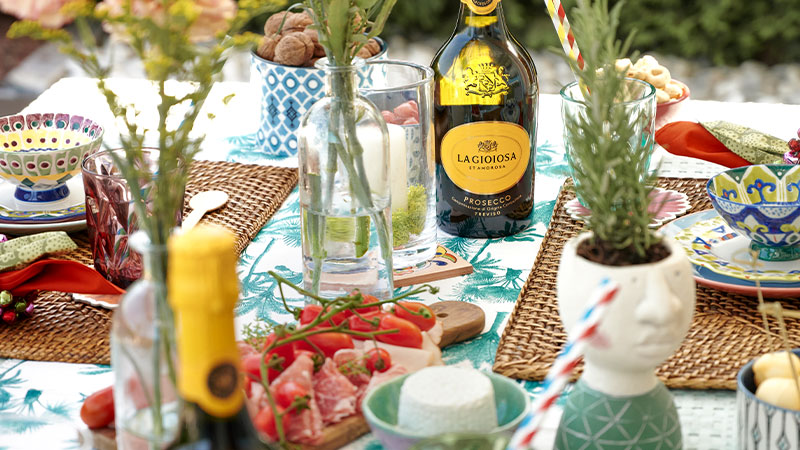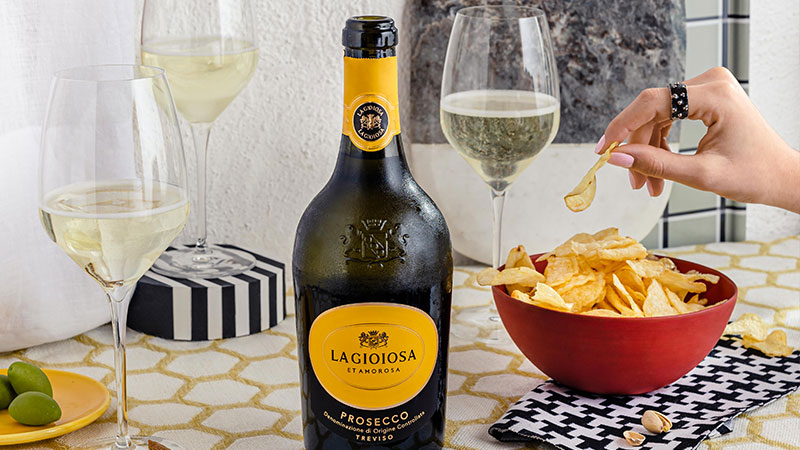
Northeast Italy is a rich, fertile region ripe for winemaking, just as it has been since the Greeks ruled the area around 800 B.C. These ancient vines include the Glera grape that is used to produce Prosecco — Italy’s once sparkling little secret that has skyrocketed in popularity in the past 10 years, with the volume of Prosecco global sales more than doubling.
Sitting at the helm is one of the top-five most well-known producers of Prosecco in the world: La Gioiosa (“The Joyous”). The Moretti Polegato family, who has owned and operated the estate since 1974, has been recognized as one of post-war Italy’s esteemed “business leaders” by the Italian Chamber of Commerce for their role in popularizing Prosecco throughout the world. But with a modern eye set on innovation, La Gioiosa is also developing ways to care for and preserve the biodiversity it relies on.
The estates commit to viticultural practices that have a low environmental impact that safeguards the unique biodiversity of the region—the wildlife, the terrain, and yes, the vines. Additionally, it’s the only way to permit the land exclusive to each estate to express itself in the most natural way.
A Brief and Bubbly History of Prosecco
A little walk down Prosecco’s history lane illustrates why La Gioiosa’s innovation is absolutely essential. Italian authorities legally protected the name “Prosecco” in 2009 after an increasing number of New World estates began using the term for their own bottlings. Today, Prosecco DOC (Controlled Designation of Origin) can only come from nine provinces in one of two Italian regions: Veneto and Friuli-Venezia Giulia. Additionally, Prosecco DOC within these regions must be produced with at least 85 percent Glera.
Commitment to Mother Nature’s Taste
The Prosecco region is dappled with wine estates like La Gioiosa, interspersed among a range of habitats that include humid lowland forests, sunny dry meadows, and a bevy of streams and ponds. It is this stable ecosystem and ideal climate conditions that produce the native thin-skinned green Glera and gives it a marked acidity, low-sugar content, and delicate notes that are ideal for producing Prosecco.
But not all Glera are alike. The same grape from a variety of nearby vineyards boasts unique flavor profiles simply because of the biodiversity specific to each estate. Many producers of Prosecco blend Glera from all around the region, standardizing the taste and profile because it’s simply an easier approach to production. La Gioiosa, however, takes infinite care in their meticulous production, ensuring that each estate produces Prosecco made entirely with the Glera from that specific vineyard. This yields unique flavor profiles representative of the natural land on which the grapes were grown and harvested.
This is all to show why Prosecco La Gioiosa intentionally engages in practices that honor and reflect the biodiversity of each estate: respect for nature and single-sourced vineyards ensure consistently high-quality, healthy, and uniquely flavored grapes that express the land like no other.
La Gioiosa is also the leader in producing environmentally friendly Prosecco, using alternative energy sources like solar power and hydroelectric power generated by the Piave River. Currently, the estate is converting its vineyards to earn the Biodiversity Friend Certification from the World Biodiversity Association. This requires enacting protocols to help encourage insect and animal life in the vineyards, thus bolstering the vitality of the soils and vines.
A Unique Take on Prosecco
In addition to Prosecco La Gioiosa’s commitment to limiting its carbon footprint, it simply produces some of the most diverse, exciting, forward-thinking sparkling wines with unique flavor profiles representative of the terroir.
Notably, La Gioiosa owner Giancarlo Moretti Polegato was the first to propose a Prosecco rosé to the Prosecco DOC consortium, recognizing a gap in the market. La Gioiosa had been growing Pinot Noir for more than four decades. Because the Glera and Pinot Noir are co-fermented, as opposed to being blended after fermentation, Polegato was confident in the wine’s remarkable freshness, depth, and nuance, which pairs nicely with complex dishes and meat entrees.
Eleven years after Polegato introduced the visionary idea, the DOC consortium approved Prosecco rosé, which contains 85 percent Glera in 2020. The new category is expected to expand wine sales by 10-15 percent.
La Gioiosa Prosecco Rosé Millesimato DOC is produced in alluvial soils rich in marl (sediment consisting of clay and lime) from the Veneto Valdobbiadene region. The addition of Pinot Noir yields a delicate shell pink color and an aroma of balanced fresh rose and pomegranate notes, pairing well with finger foods and first-course Mediterranean dishes.
Interested in experiencing other authentic and leading Proseccos from an estate that practices what they preach when it comes to transparency, provenance, and environmentally-minded production and distribution? Here are just a few of the estate’s top-notch options:
La Gioiosa Prosecco DOC Treviso, produced from 100-percent Glera grown in the morainic hills (an accumulation of boulders, stones, and other debris carried and deposited by glaciers), boasts a fruity and flowery aroma with hints of ripe golden apple and small mountain flowers. The pale straw yellow bubbly is an excellent apéritif to complement savories. It’s ideal for steamed shellfish dishes.
La Gioiosa Valdobbiadene Prosecco Superiore DOCG hails from one of the finest Prosecco-producing municipalities. It possesses an intensely fruity aroma with hints of ripe golden apple. Fresh, slightly sweet with an agreeable finish, this wine is ideally served alongside fish marinated with aromatic herbs and other herb-based first courses.
La Gioiosa Low Cal Prosecco DOC is fruity and flowery, fresh and flavorsome on the palate, but with lower calories than a standard glass. Made of 100 percent Glera from the Veneto and Friuli Venezia Giulia region, it’s an excellent apéritif and an ideal pairing with steamed shellfish.
Prosecco is inherently Italian and an expression of terroir, especially when choosing not to blend estates but honor the biodiversity of each. It is the care in production and appreciation for the land that lends itself to Proseccos growing in popularity. It’s accessible, fresh, and affordable — a drink for any and every occasion — and in the case of La Gioiosa, a pure expression of the land. When you choose La Gioiosa, you’re choosing authentic Italian flavor without compromise.
This article is sponsored by La Gioiosa.





